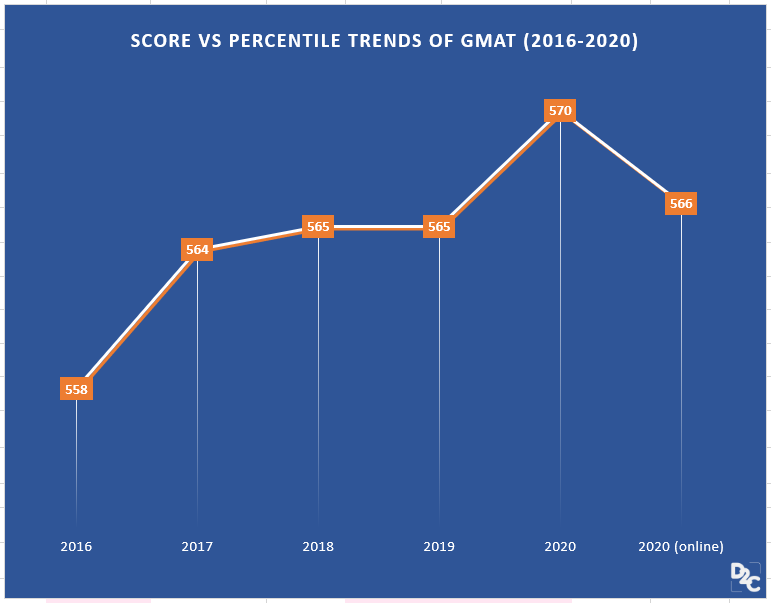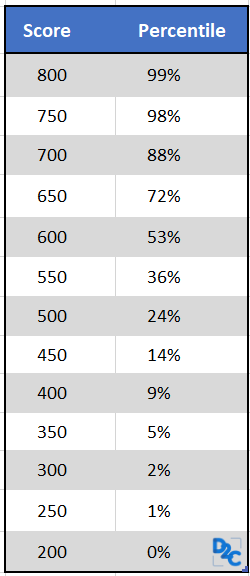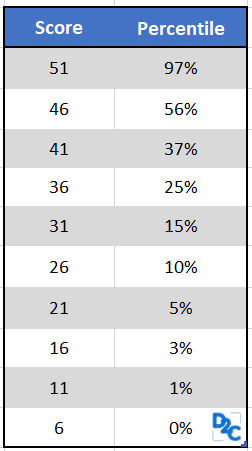The basics of GMAT quant preparation that you must know!

GMAT is an examination for getting admission into the best B-Schools across the globe. Annually, on average around 2,00,000 candidates take the GMAT exam each year. And to get ahead in this staunch competition, a candidate needs to get a great score and percentile. So without any delay, let’s first understand the various sections in GMAT.
The four sections of GMAT include:
- Analytical Written Assessment (AWA)
- Integrated Reasoning
- Quantitative Reasoning
- Verbal Reasoning
NOTE: The total score of all the sections collectively is 800 marks.
Here is a representation of GMAT scores vs percentile over the years.

Note: GMAT 2020 was also conducted in online mode as well.
For a clearer view, here is the overall GMAT score and respective percentiles (based on January 2018 - December 2020)

All about GMAT Quantitative Reasoning
Quantitative Reasoning tests your mathematical and data analysis ability, and reasoning skills. To score high on GMAT, you would need to score big in the quant section as well. Now, let's look at the structure of the quant section.
For the quant section, you will have to solve 31 multiple-choice questions in 62 minutes. That means if you were to attempt all questions, you would get 2 minutes per question. There are five answer choices for each question with one being correct. For each correct answer, candidates secure one raw point. The score in this section ranges from 6-51 marks. Also, note that this test is adaptive, which means as you move ahead with each answer being correct, the level of difficulty increases. Also, you will not be able to skip, return to, or change your answers to questions. So, mark your answers wisely considering all answer choices.
Usually, the score and percentile of the GMAT Quant section lie around the following figures (based on January 2018 - December 2020):

Types of questions asked in GMAT Quantitative Reasoning
The GMAT Quantitative section has two parts:
Problem Solving
Problem-solving measures your ability to use logic and analytical skills to solve mathematical problems. The mathematics required here is no greater than the secondary school classes. So, if you are not in touch with Mathematics, you would need revision, but no advanced mathematical skill set is required.
For example,
Question: How many integral divisors do the number 120 have?
Options:
- 14
- 16
- 12
- 20
- None of these
Data Sufficiency
This part is different from the Problem Solving section. It does not focus on getting the answer correct, but you need to select the option that gives you sufficient information to get to the answer. Let's make this part more clear by taking a rudimentary example. Consider a circle, we need to find its area. But for that you need the radius of the circle, right? That's what sufficiency is: Finding what is necessary to get to the correct answer and not the actual answer.
Let's look at the format of such questions: There are two statements out of which you need to choose the correct option as given below:
(A) Statement 1 alone is sufficient, but statement 2 alone is not sufficient to answer the question.
(B) Statement 2 alone is sufficient, but statement 1 alone is not sufficient to answer the question.
(C) Both statements taken together are sufficient to answer the question, but neither statement alone is sufficient.
(D) Each statement alone is sufficient.
(E) Statements 1 and 2 together are not sufficient, and additional data is needed to answer the question.
Now, let’s talk about the mathematical topics on which questions generally appear on the GMAT.
GMAT Quant syllabus
Broadly speaking, there are four areas tested in GMAT:
- Word problems: This consists of problems given in 3-4 sentences where candidates need to find some value like profit or loss, age of some person, etc. This section usually has maximum weightage, so pay more attention here.
- Arithmetic: In Arithmetic, problems are based on Fractions, Percentages, Decimals, Time and Work.
- Algebra: Algebra has topics like variables and functions. Also, there are equation-based questions like linear equations and quadratic equations.
- Geometry: This part, as we have done in school, deals with shapes and their properties. We need to find the area of some figure or some angle (say x) of a triangle. The list of topics covered includes quadrilaterals, triangles, circles, solids, and cylinders, and coordinate geometry.
Books for GMAT Quant preparation
Refer to the following table for some of the best GMAT quant books (this is just a reference and can work differently for everyone)

How to study for the GMAT Quantitative section?
Now, when you are clear with the syllabus and the books to refer to, the next question in mind is how to master the section. So, here are five important tips at your disposal:
- Focused reading: If you need to solve a problem, then you need to understand the problem clearly. Reading at a moderate pace with concentration should be sufficient to help you understand the problems.
- Mental math: Since you don't get to use a calculator, so it's better to spend time practicing math problems without using one.
- Time management: In any exam, this skill is paramount. In GMAT Quant, candidates have approximately 2 minutes per question, so students need to note that and plan their time accordingly. It's not wise to spend 5-6 minutes on a question, instead, you can do two questions in that time frame!
- Art of leaving tough questions: Entrance exams like GMAT are skill-based, so it's best to identify tough questions and leave them as they would consume much time with less accuracy.
- MCQ techniques: Let's say for a problem, we need to find some value x. Consider an example, let’s say there were x people, and one-fourth of them were promoted. Now, we know that x is an integer, as it represents the number of people.
Consider options,
- 13
- 15
- 17
- 16
- 21
The answer is 16 as it is the only option which is the multiple of 4. This is just an example, but you can devise other smart ways of finding the answer using options.
All in all, knowing the syllabus, pattern and tips are important but time and stress management are paramount for an exam like GMAT. So, it is advisable that students give an ample number of mock tests to get familiar with these skills essential to get into a great B-School.
Other resources that you may need for GMAT preparation:
Login to continue reading
And access exclusive content, personalized recommendations, and career-boosting opportunities.
















Comments
Add comment